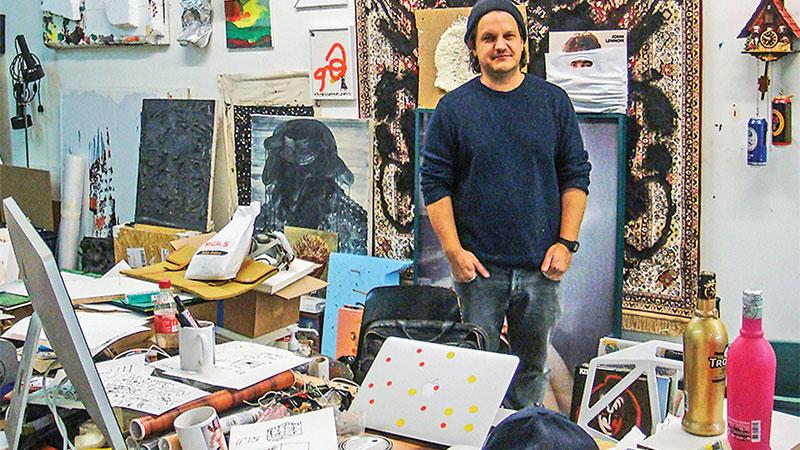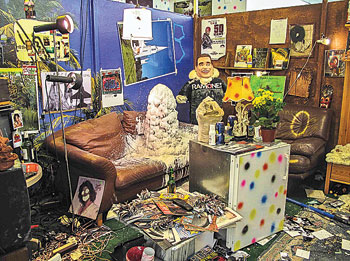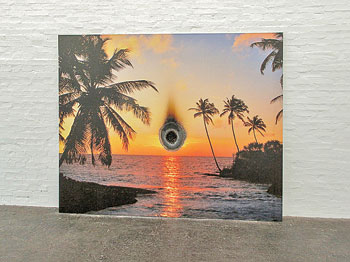
CB: Thanks for taking the time to do this interview. I want to talk about your biography first. You attended the graphics class at the School of Design in St. Gallen. What did you take away from this training?
BB: Craft, maybe. Dealing with the computer and the visual, with forms. But it was a tough time. I am actually a dilettante. I just do everything the best I can. So far I want to do everything myself. Sculptures as well, as best as I can.
CB: Do you come to the studio every day? Do you have a regular daily routine?
BB: Yes, almost every day, actually. In the morning between 8 and 10 am I take the train and in the evening it sometimes takes longer. That’s already settled, yes. Sometimes on weekends I only come here for an hour or two, or I do something at home.
CB: Did you always realise that you wanted to be an artist?
BB: I didn’t really want to consciously. It just happened. I kind of had to accept that I was doing this now.
Q: You didn’t grow up in an artistic environment?
BB: Already interested in art. My great uncle was an artist. We also had contact with him. So I was already in an environment that supported me morally, or that accepted what I was doing from the start. Otherwise I might not be around now, that’s one reason.
CB: Then your first access to art was your great-uncle? Or was there any other artist or work that impressed you?
BB: Well, I have already had experiences in museums with works where I knew exactly, I want that too. Especially with paintings. That has always fascinated me. So the classics. Pop Art was an approach, or Jackson Pollock, back then. The American. So this combination. Pop Art and this Expressionist, abstract. What else fascinated me? Yes, especially painters. And I still feel like a painter, even though I don’t paint that much. It’s just like the goal.
CB: I understand that in your work. So, that you feel like a painter.
BB: Even when I make a sculpture, there is often something picturesque about it. You know, this combination in the affect, the expression in three-dimensional space.
CB: Are you planning your career?
BB: No. Do not plan rationally. I’m actually still surprised. Sometimes I feel like I can’t do anything (laughs). At some point someone comes around the corner and says: “I caught you! You can’t do anything! ”I am very intuitive, I think. Over the past eight years, I’ve had a good feeling about what something could become. But everything is based on the hope that it will work out. There are existential fears, sometimes and sometimes not. Or how do you plan? I can’t plan that well.
CB: I meant if you are pursuing any strategy.
BB: Give everything for every exhibition, actually. In the past two years, that has sometimes been neglected. But it is really important that you give your all, throw up and push yourself to the limit. That’s my strategy. Step by step.
CB: I would like to come back to your work again, specifically to the genres. You mainly work in the classic art genres of drawing, painting and sculpture. Was there a specific reason to choose?
BB: Well, I think drawing is the best anyway. It doesn’t cost anything, you can do it anywhere, you don’t need anything. I think that’s a good reason to draw. I’ve always drawn, too, and you probably used to too. You can express worlds and thoughts so quickly. I like painting for sensual reasons, I don’t know exactly either. A picture on the wall is actually a bit stupid, but I’m such a fan of painting.
CB: You also often work with image-text combinations. Which is first in each case? The picture or the text? And is sculpture the next logical step?
BB: The sculpture rarely develops directly from the drawing. With the drawings I sometimes do the picture first and then the text, sometimes I have an idea for a combination beforehand, or the text comes later, after two days or so. And when I find a good text, a good headline from the newspaper, I write it down and then I think of something. But the drawing may not be good then. Then I’ll just do the next one, and that might be good. (Break). For example, we are currently doing a book for Patrick Frey, this is a collection of texts. It consists of texts that interest me or that could become the starting point for work. (Break). And the sculptures are not so related to the texts, they are more about trying out materials. Clay and plaster, spray paint. Cheap materials, anything that is easy to use. Everything happens in the affect, I don’t have time (laughs). No patience, I should perhaps rather say.
CB: You also like to work with found pictures from magazines or with record covers. Do you have some kind of picture pool? Or how does a picture get you to edit it further?
BB: I have an intellectual fund. Worlds that interest me. Pop culture or everyday life, clichés, symbols, interests from the past, for example bands. Just topics that I like.
CB: So. you haven’t created a picture collection?
BB: No. Although I would like that. I would very much like to have text and image archives. But mostly a topic arises before an exhibition. Then I decide on something that I’ve wanted to do for a long time. I then either deconstruct something, the cuckoo clock, this harmless, idyllic view of the world, or then there is work on global corporations, Nike shoes, or there are things that I really like, records or something. What else was there? I also find fashion photography exciting. I want to learn that then. It just kind of happens, and sometimes it’s good, sometimes it’s not.
CB: How important is the space for your work? It struck me that you tend to include space in exhibitions in an institutional setting than in gallery exhibitions.
BB: It’s always a big topic. If I get the opportunity, I’ll be happy to do it, such a universe of my own. Marking everything is a topic. Mark the wall. (Break). I also think it’s good to just hang up paintings. Just not always. This year I had two shows, they were like that. We just hung the paintings on the wall. But that also depends on the gallery owners. Some galleries don’t want spray-painting on the wall, then it’s all over. I am flexible there. (Break). Nicola von Senger, on the other hand, is extremely cooperative, I have to say. You can do what you want there. It doesn’t happen that often.
CB: Finally, I would like to ask about your future projects. What are you working on right now, apart from the exhibition at the St. Gallen Art Museum ?
BB: Exactly, the exhibition in the art museum in February. And then an exhibition in Salzburg in the Fotohof. It’s kind of like an art gallery and they only show photography-related work. I’m not a photographer, but there are a lot of works that are based on a photo. These finger works, for example. And then in autumn there is a solo exhibition in the Museum Boijmans van Beuningen in Rotterdam . Also a couple of group shows, probably. That often comes at short notice.
CB: One last question: Which work, project or which group of works within your work is particularly important to you?
BB: Good question (thinking about it). The painting.
CB: Do you have a favorite drawing?
BB: No, not really. So. the crowd. I like the whole stack.
